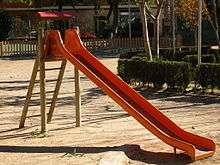Playground slide

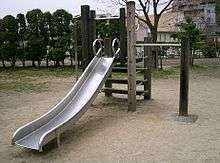
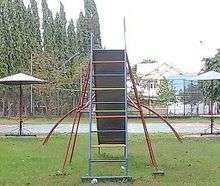
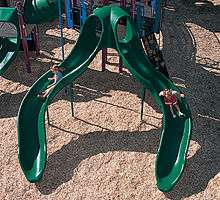
Playground slides are found in parks, schools, playgrounds and backyards. The slide may be flat, or half cylindrical or tubular to prevent falls. Slides are usually constructed of plastic or metal and they have a smooth surface that is either straight or wavy. The user, typically a child, climbs to the top of the slide via a ladder or stairs and sits down on the top of the slide and "slides" down the slide. In Australia the playground slide is known as a slide, slippery slide, slipper slide or slippery dip depending on the region.
Sliding pond or sliding pon is a term used in the New York City area to denote a playground slide.[1] Sliding board is used in the Philadelphia area and other parts of the Mid-Atlantic.[2]
History
.jpg)
Manufacturers Wicksteed claim that the slide was invented by founder Charles Wicksteed, and the first slide, made of planks of wood, was installed in Wicksteed Park in 1922.[3] The discovery of Wicksteed's oldest slide was announced by the company in 2013.[4]
However, this has been disputed by others who refer to a roof-top slide in NYC c.1900, the nursery slide of the young Tsar Alexei, at Alexander Palace in Tsarkoye Selo built around 1910, the 45-foot (13.7m) slide at the Smith Memorial Playground in Philadelphia which was installed in 1904 (renovated and reopened in 2005), or the c. 1905 Coney Island Slide.[5]
Indeed Arthur Leyland's book Playground Technique and Playcraft Vol 1 originally published in 1909 and revised in 1913 gives full instructions for the construction of a metal playground slide.[6]
Spiral slides
A playground slide may be wrapped around a central pole to form a descending spiral forming a simple helter skelter.
Amusement park slides
Larger versions of the playground slide are much higher with multiple parallel slideways. Participants may be provided with a sack to sit on to reduce friction for faster speeds and to protect clothing.
A variation of a slide is used in waterparks and swimming pools and is called a water slide.
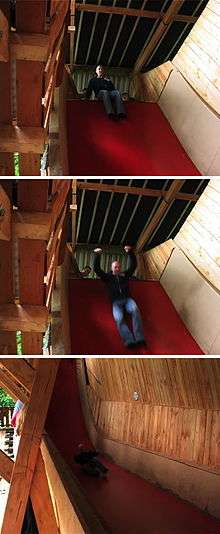
Drop slide
A slide that starts with a vertical or near-vertical drop is called a drop slide (also known as a death slide or free-fall slide). Slides of this sort are often found at amusement parks in the United Kingdom.
 An inflatable slide at an air show in England.
An inflatable slide at an air show in England. at a community festival in Australia.
at a community festival in Australia.- An amusement park slide
Safety
Playground slides are associated with several types of injury. The most obvious is that when a slide is not enclosed and is elevated above the playground surface, then users may fall off and incur bumps, bruises, sprains, broken bones, or traumatic head injuries. Some materials, such as metal, may become very hot during warm, sunny weather.
Some efforts to keep children safe on slides may do more harm than good. Rather than letting young children play on slides by themselves, some parents seat the children on the adult's lap and go down the slide together.[7] If the child's shoe catches on the edge of the slide, however, this arrangement frequently results in the child's leg being broken.[7] If the child had been permitted to use the slide independently, then this injury would not happen, because when the shoe caught, the child would have stopped sliding rather than being propelled down the slide by the adult's weight.[7]
See also
- Jungle gym (monkey bars)
- Outdoor playset
- Swing (seat)
- Slide (disambiguation)
Notes
- ↑ Gold (1981)
- ↑ "Dialects of English". webspace.ship.edu. Retrieved 2016-01-16.
- ↑ "World's first children's slide". BBC. 2012-03-17. Retrieved 2012-03-18.
- ↑ "Is this the oldest swing in the world?" http://www.wicksteed.co.uk/is-this-the-oldest-swing-in-the-world-n196.html
- ↑ "World's First Playground Slide, says the Daily Mail? Not. - Playscapes". Playscapes. Retrieved 2016-04-13.
- ↑ Leland, Arthur; Leland, Lorna Higbee (1913-01-01). Playground technique and playcraft. Doubleday, Page.
- 1 2 3 Parker-Pope, Tara (23 April 2012). "Well: At Playground, Child Plus Lap Can Equal Danger – NYTimes.com". The New York Times. Retrieved 2012-04-24.
Sources
- Gold, David L. (1 January 1981). "Three New-York-Cityisms: Sliding Pond, Potsy, and Akey". American Speech. 56 (1): 17–32. doi:10.2307/454476. JSTOR 454476.
| Wikimedia Commons has media related to Playground slides. |
